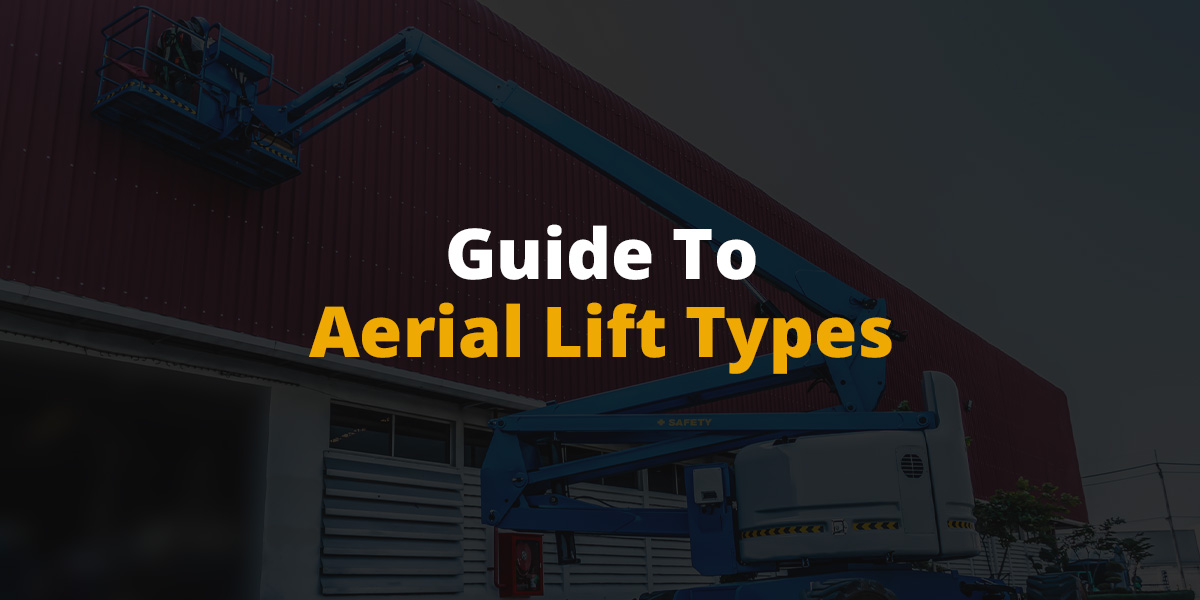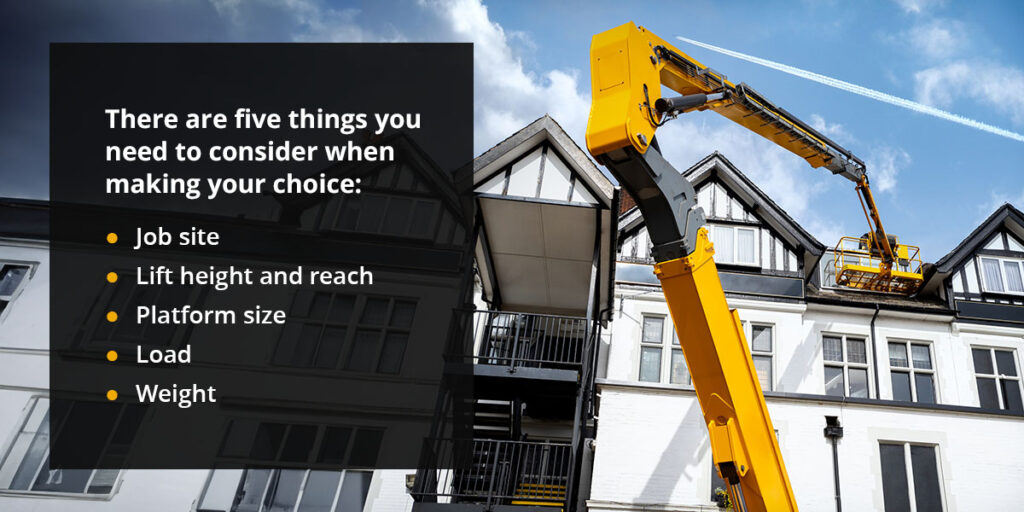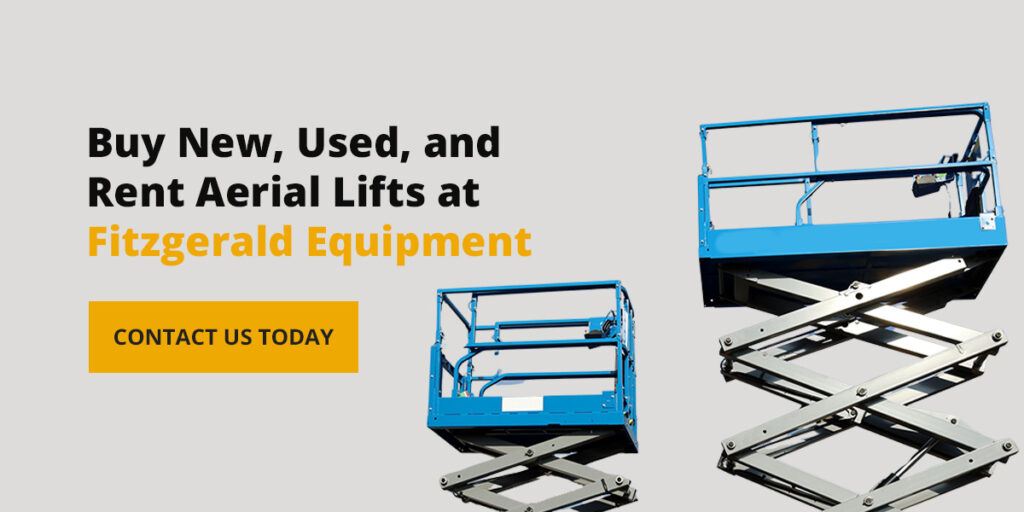
When working on tall structures and multistory buildings, you need to be able to safely and reliably reach the areas you’re working on. The best way to get up to those heights is with an aerial lift. This guide will explore the different varieties of aerial lifts, what they do best and how to choose the right one for your work.
What Is An Aerial Lift Used For?
Aerial lifts are construction machinery used as a more versatile substitute for ladders and scaffolding. They’re used for a wide variety of different jobs, like installing ductwork and building wiring. Aerial lifts are also used to access work on heating, ventilation and air conditioning (HVAC) units and pipes. There are several types of aerial lifts, each with its own advantages and features.
The Different Types of Aerial Lifts
Four main types of lifts are used in the construction industry — scissor lifts, aerial ladders, boom lifts and telehandlers. Exploring the key features of each type of aerial lift will help you choose the right one you need for your work every time.
What Is A Scissor Lift?
A scissor lift is a mobile platform that raises workers vertically. It comes equipped with a driving compartment used to move workers and the lift throughout a construction site with accordion-like arms that extend up and down to reach high places safely. The height it can reach and the platform size can vary based on your site and requirements. Scissor lifts are large enough to carry and support a number of workers and tools.
There are five different types of scissor lifts that are better suited for different types of work and site locations:
- Electric scissor lift: Electric scissor lifts are lighter and more nimble than their diesel counterparts. They are quiet and release no toxic fumes, making them ideal for indoor use.
- Diesel scissor lift: Diesel scissor lifts are extra powerful, providing a sturdy lift and being able to support heavier loads with larger platforms. In exchange for this power, they are louder and exude a lot of fumes. They are a reliable tool best suited for outdoor use.
- Rough terrain scissor lift: This type of scissor lift is equipped with heavy-duty tires and extra safety features, making it the best choice when working outdoors on uneven terrain.
- Pneumatic scissor lift: A pneumatic scissor lift uses air pressure to move its platform. As a result, their power is lower than other scissor lifts, but they don’t emit fumes. This is an excellent choice for indoor construction projects.
- Hydraulic scissor lift: This is a hand-operated scissor lift. The crank system and hydraulic oil work together to raise and lower the platform. When used in the cold, it can become slower as the oil becomes stickier and thicker in lower temperatures. This is a useful option, but you must consider the environmental conditions you’re working in.
What Is An Aerial Ladder?
Aerial ladders are a type of aerial lift mounted to trucks. They are mechanically operated ladders that allow quick and easy access to high locations. Their compact design makes them a great choice when working on sites with limited space. An aerial ladder is a solid choice when working on tall buildings or poles. They are generally safe, easy to use and less bulky than other aerial lift options.
What Is A Boom Lift?
A boom lift is a vehicle with a single arm carrying a small platform. The arm extends outwards and can reach incredible lengths or heights. They are best suited for work on tall buildings that require a limited number of workers, like wiring repair and maintenance. There are three main types of boom lifts:
- Cherry picker: A cherry picker attaches to a truck and can reach tree tops and power lines. It’s commonly used to pick fruits in orchards, hence its name.
- Articulating boom lift: An articulating boom lift has a jointed arm designed to bend in different ways to maneuver around obstacles. The specialized arms help the platform reach areas at awkward angles and hard-to-reach spots in tall places.
- Telescopic boom lift: Telescopic boom lifts extend in a straight line, like a telescope. They have no joints like articulated boom lifts do. Their straight arms make them ideal for working in high places where much reach is required.
What Is A Telehandler?
A telehandler is a combination of a forklift and a boom lift. It utilizes the mechanics of a forklift with the reach of a boom lift. The further the telehandler’s arm is extended, the less it is able to carry, making it vital to know how much you need to lift and how far you need to reach. There are two types of telehandlers:
- Fixed telehandlers: Fixed telehandlers focus on reach. Their arms have no rotating capability, and their movement depends on the way their arm extends.
- Rotating telehandlers: Rotating telehandlers have a turret that rotates in various directions for increased versatility. The rotating turret makes this telehandler capable of moving equipment to any location on your worksite.

How to Choose the Right Type of Lift
Picking the right aerial lift comes down to knowing what they are best suited for and the type of work you will do. There are five things you need to consider when making your choice:
- Job site: When working indoors, a zero-emission lift is your best option, like electric and pneumatic scissor lifts. In a crowded area, the articulating lift will help navigate narrow and obstructed spaces. You will want to use the rough terrain scissor lift when working outdoors and on uneven terrain.
- Lift height and reach: The height of your working area is an important consideration. You need to know how far your lift needs to go and the direction it needs to move. For example, this determines if you need a scissor lift or an articulating boom lift. Your choice of aerial lift needs to give you the right access to the area you are working on.
- Platform size: Scissor lifts have bigger platforms than boom lifts. Wide platforms can carry less because they’re heavier, but your platform size will depend on the type of work that needs doing and the number of workers and tools required.
- Load: Your aerial lift must be able to support your needed load capacity. This includes size and weight. Your tools should not hang over the edge and must be light enough to carry with your workers.
- Weight: When you need to carry materials, tools and workers, you must know how far your lift can carry all that weight. Knowing the manufacturer’s weight limits can save you a lot of time and energy and greatly increase the safety of your work.

Buy New and Used Aerial Lifts at Fitzgerald Equipment
Fitzgerald Equipment has what you need if you need a new aerial lift or are looking for aerial lift rentals. With over 60 years of helping customers, we know how to find the exact machinery you’re looking for. We take pride in the high-quality machinery we’ve sold to our customers throughout Wisconsin and Illinois over the years. Our family-owned business only uses the best material-handling equipment from trusted manufacturers.
To learn more about the models we sell or if you want to purchase a new or used aerial lift, contact us today.



